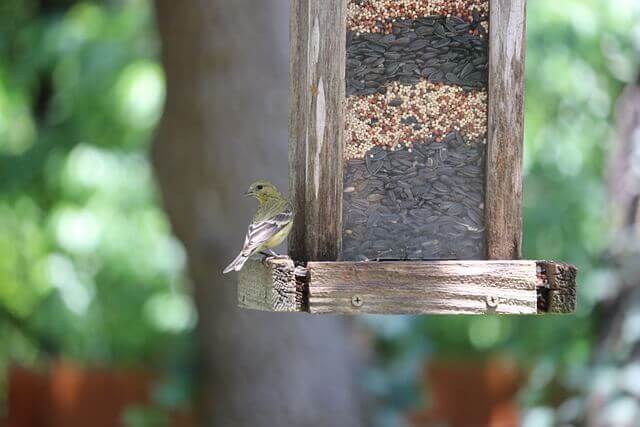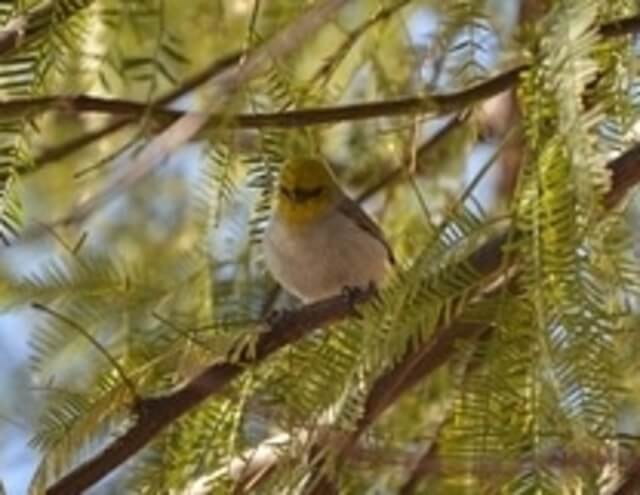Nevada’s diverse landscapes, encompassing deserts, mountains, and wetlands, offer a unique habitat for a variety of bird species. In this comprehensive guide, we’ll introduce you to the 63 most common birds you can find in Nevada.
Explore their distinct habitats, behaviors, and prime spotting locations across the Silver State, making this your essential guide for birdwatching adventures.
Table of Contents
- 1 Most Common Birds In Nevada
- 1.1 Mourning Dove
- 1.2 House Finch
- 1.3 Common Raven
- 1.4 White-crowned Sparrow
- 1.5 American Robin
- 1.6 Yellow-rumped Warbler
- 1.7 Northern Flicker
- 1.8 Rock Pigeon
- 1.9 European Starling
- 1.10 Red-winged Blackbird
- 1.11 Lesser Goldfinch
- 1.12 Eurasian Collared-Dove
- 1.13 Killdeer
- 1.14 House Sparrow
- 1.15 Great-tailed Grackle
- 1.16 Song Sparrow
- 1.17 Verdin
- 1.18 Dark-eyed Junco
- 1.19 Northern Mockingbird
- 1.20 Say’s Phoebe
- 1.21 Bewick’s Wren
- 2 Frequently Asked Questions
- 2.1 What are the black birds in Nevada called?
- 2.2 Are there finches in Las Vegas, Nevada?
- 2.3 What are Nevada bluebirds?
- 2.4 What kind of birds are at Lake Mead?
- 2.5 Are there ravens or crows in Las Vegas?
- 2.6 Are Ravens in Nevada?
- 2.7 Are there blue jays in Nevada?
- 2.8 Are there egrets in Nevada?
- 2.9 Are there loons in Nevada?
- 2.10 Are there catbirds in Nevada?
- 2.11 Are there parrots in Nevada?
- 2.12 Are there peacocks in Nevada?
- 2.13 Are there starlings in Nevada?
- 2.14 Are there roadrunners in Nevada?
- 3 Author
Most Common Birds In Nevada
Mourning Dove
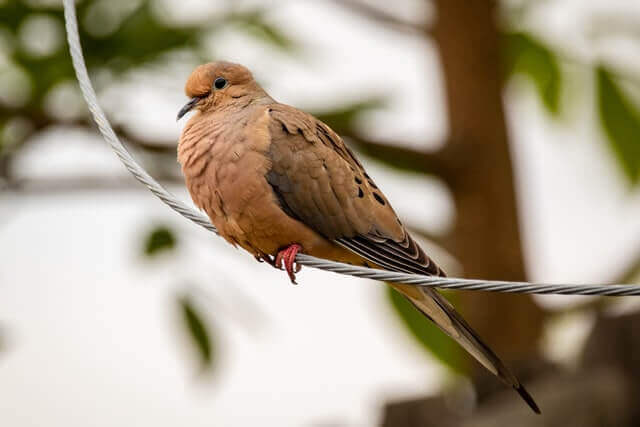
Mourning Dove is a widespread bird that is found in many regions of North America. Its range extends from the Canadian border to the northern borders of Mexico. The Mourning Dove prefers open habitats such as fields, prairies and farmland. It is also commonly found in suburban areas.
The Mourning Dove feeds mainly on seeds, but will also eat insects and berries. The bird typically forages on the ground, using its long beak to pick up food items. The Mourning Dove is an important bird species in North America and is hunted for sport in many states.
- Frequency: 35.57% (Statistic: eBird)
- Color: Light gray-brown and lighter and pinkish below. The wings have black spots.
- Habitat: Open habitats, urban areas, farms, prairie, grassland, wooded area
- Range: USA, Canada, Mexico, Central America, Greater Antilles
- Size: 12″ inches length
- Weight: 112 – 170 grams
- Diet: Rapeseed, corn, millet, safflower, sunflower seeds, pokeberry, sesame, and wheat.
- Family: Columbidae
- Genus: Zenaida
- Maps: Range Map – Sightings Map
- Sounds: Songs and Calls
Related:
- Best Bird Feeder For Doves (Reviewed & Tested for 2022)
- Facts About Mourning Doves – 10 Things You Need To Know!
House Finch
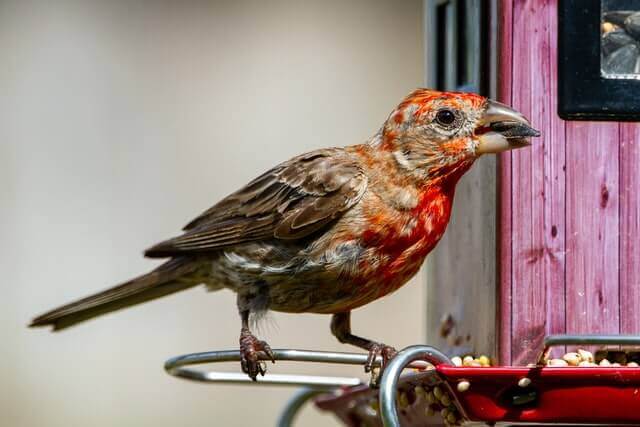
The House Finch is a small songbird that is found in North and Central America. The bird’s natural range extends from Alaska and Canada to Mexico and Guatemala. The House Finch has also been introduced to Hawaii, Puerto Rico, the Virgin Islands, and parts of Europe. The bird’s habitat includes open woodlands, fields, gardens, and urban areas. The House Finch feeds on grains, seeds, fruits, and insects.
The House Finch is a common bird at backyard feeders throughout much of North America. The male finch has a reddish head and breast, with brown streaks on its back and wings. Females are usually grayish-brown with streaked upper parts. Both sexes have dark brown eyes and grayish bill. Juvenile birds are similar in appearance to adults, but have softer plumage colors.
- Frequency: 27.92%
- Color: Reddish face and upper breast, brown streaks on back, belly, and tail.
- Habitat: urban and suburban areas, backyards, edges, yards, and parks.
- Range: Canada, USA, Mexico
- Size: 5 – 6″ inches
- Weight: 16 – 27 grams
- Diet: Aphids, grains, seeds, berries, nettle, dandelion, sunflower seeds.
- Family: Fringillidae
- Genus: Haemorhous
- Maps: Range Map – Sightings Map
- Sounds: Songs and Calls
Related:
Common Raven
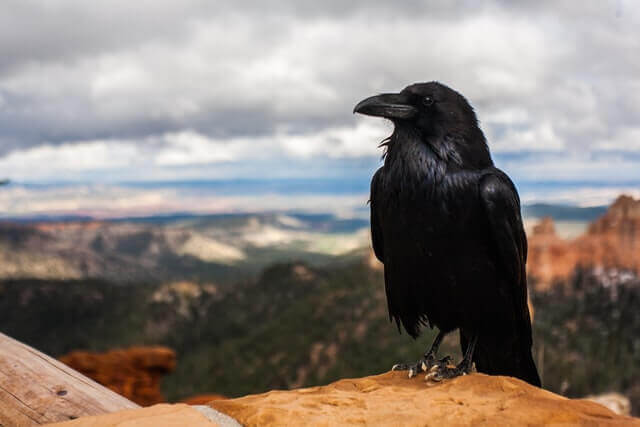
The most widespread corvid is the Northern Raven (Corvus corax), which is found in northern regions around the world. A member of the crow family, it is distinguished from its relatives by its larger size, shaggy throat feathers, and deep, hoarse voice. It is one of the smartest birds, with a capacity for tool use and mimicry. Common ravens are also known to live up to 13 years in the wild.
The Common Raven has a vast range, extending across most of the Northern Hemisphere from the Arctic Circle to North Africa, Central Asia, and the western United States. In North America, its range includes most of Canada and Alaska, as well as parts of the contiguous United States.
- Frequency: 25.19%
- Color: All black iridescent plumage
- Habitat: Wooded areas, evergreen forests, tundra, roadside, grasslands, backyards, parks
- Range: Found throughout the Northern Hemisphere
- Size: 21 – 26 inches long
- Weight: 1.5 – 4.5 lbs.
- Diet: Mainly scavengers, feeding on carrion, beetles, and maggots.
- Family: Corvidae
- Genus: Corvus
- Maps: Range Map – Sightings Map
- Sounds: Songs and Calls
Related: 18 Fun Facts About Ravens That Will Amaze You
White-crowned Sparrow
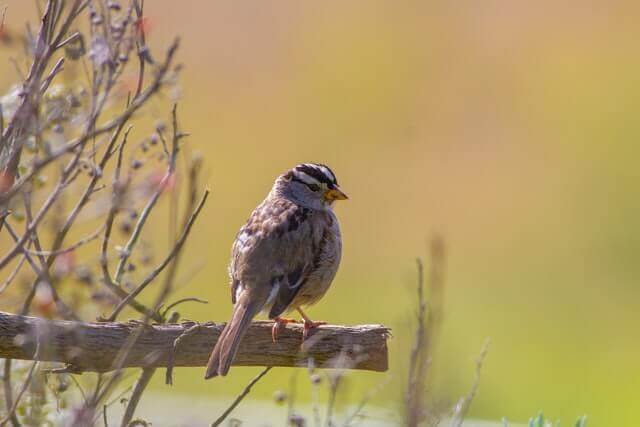
The White-crowned Sparrow (Zonotrichia leucophrys) is a medium-sized sparrow with distinctive white stripes on its head. It is a common bird in North America, where it is found in open habitats such as fields and gardens. The White-crowned Sparrow has a wide range, from Alaska to Newfoundland in the north, and south to California and Mexico. In the east, its range extends to the Great Plains.
The White-crowned Sparrow is a year-round resident of most of its range. It breeds in open habitats across Canada and the northern United States. The diet of the White-crowned Sparrow consists mainly of seeds and insects. In winter, when food is scarce, it will eat berries and other fruits.
- Frequency: 24.88%
- Color: Black and white stripes on their head, gray face, brown-streaked upper, and a long tail. Brown wings with bars, and the underparts are gray.
- Habitat: Brushy areas
- Range: Western USA, and Northern Canada
- Size: 5.9″ – 6.3″ inches long
- Weight: 25 – 28 grams
- Diet: Seeds, insects, and plants
- Family: Passerellidae
- Genus: Zonotrichia
- Maps: Range Map – Sightings Map
- Sounds: Songs and Calls
American Robin
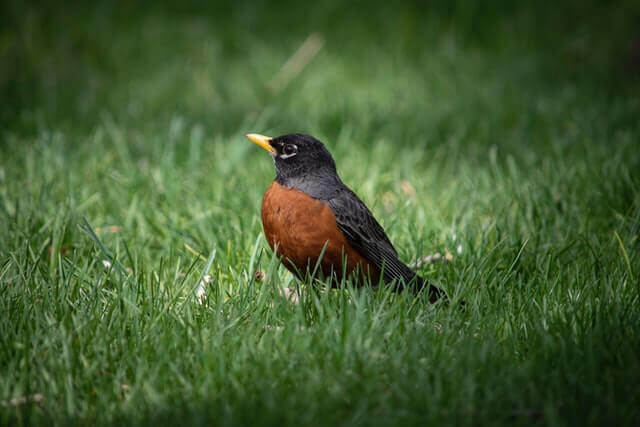
The American Robin is an attractive, non-migratory songbird of both the true robin genus and Turdidae, both of which are a sub-order of the ornithology group of birds, and the larger thrush family. They have been recorded as living on islands in the Pacific, in Mexico, Central America, South America, and the Caribbean, and as the resident birds of buildings in the United States and Canada.
A number of species of this genus are common throughout most of the United States and Canada. All of these birds feed on a variety of foods, including nectar, leaf buds, berries, seeds, insects, and small fish. Some of them are common visitors to bird feeders, and others are more solitary and frequent travelers.
- Frequency: 22.34%
- Color: Mostly brown on the back with an orange colored breast
- Habitat: Wooded areas, backyards, parks, fields
- Range: USA, Canada, Mexico
- Size: 12 – 16″ inches
- Weight: 72 – 95 grams
- Diet: Fruits, berries and insects (earthworms, beetles, caterpillars
- Family: Turdidae
- Genus: Turdus
- Maps: Range Map – Sightings Map
- Sounds: Songs and Calls
Related:
Yellow-rumped Warbler
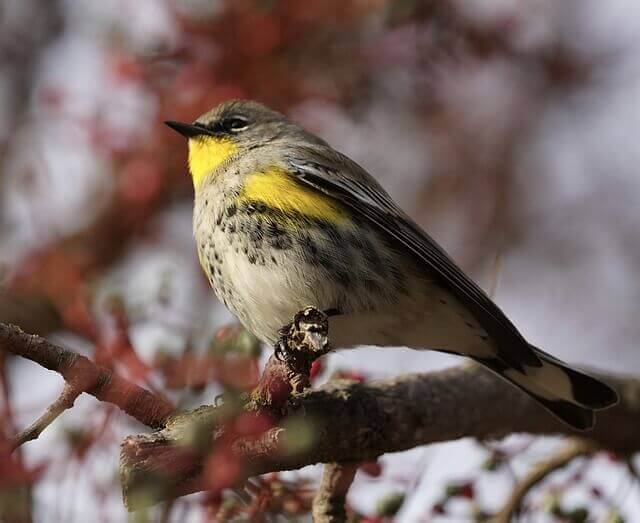
The Yellow-rumped Warbler is a small songbird that breeds in North America. It is a very widespread breeder, from Alaska and Canada to the northeastern United States and Mexico. The warbler’s range also extends into the West Indies. This bird is a non-migratory resident in most of its breeding range, but some northern birds do migrate south for the winter.
The Yellow-rumped Warbler inhabits a wide variety of habitats, including boreal forests, coniferous woods, deciduous forests, and even urban parks and gardens. It is generally found in wooded areas, but can also be seen in open fields and along roadsides. The diet of the Yellow-rumped Warbler consists mainly of insects and other small invertebrates. The warbler will also eat berries and fruit when they are available.
- Frequency: 21.96%
- Color: Yellow patches on the crown, flanks, rump & blackish-blue streaks on the back, breast and wings
- Habitat: Deciduous forests and thickets, roadside, grasslands, backyards
- Range: U.SA, Canada, Mexico, Central America, and the Caribbean
- Size: 4.7 – 5.9″ inches
- Weight: 10 – 18 grams
- Diet: grasshoppers, gnats, aphids, caterpillars, wasps, beetles, spiders, berries,
- Family: Parulidae
- Genus: Setophaga
Related: How to Attract Warblers to you Yard?
Northern Flicker
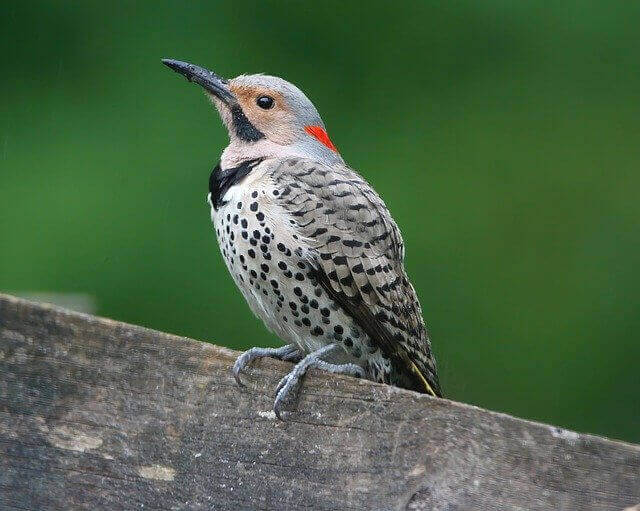
The Northern Flicker is part of the woodpecker family. It is native to North America and can be found in forests, woodlands, and open habitats such as parks and gardens. The Northern Flicker has a large range, extending from Alaska and Canada to Mexico and the Caribbean. The bird is also found in parts of Central America and South America.
The Northern Flicker is a medium-sized bird with a long tail and black-and-white striped wings. The bird’s head is brown with a red patch on the forehead. The Northern Flicker feeds on ants, beetles, caterpillars, fruits, nuts, and seeds. The bird uses its long tongue to reach into crevices in trees to find food. The Northern Flicker excavates nesting cavities in trees using its powerful beak.
- Frequency: 20.73%
- Color: Light brown with black bars across back, chest, wings, belly
- Habitat: Forests, woodlands, backyards, edges, yards, and parks
- Range: North America, Central America, Cuba, Cayman Islands
- Size: 10 – 14″ inches
- Weight: 85 – 165 grams
- Diet: Insects (ants, beetles, invertebrates), fruits, seeds, berries
- Family: Picadae
- Genus: Colaptes
Related: How to Attract Northern Flickers to your Backyard? (Easy)
Rock Pigeon
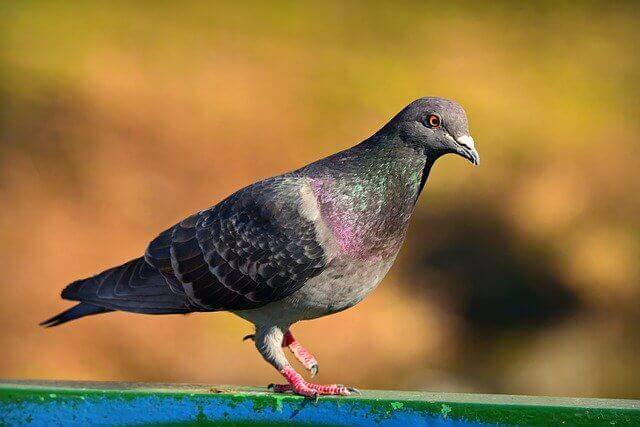
The rock pigeon is a part of the Columbidae family. The species includes the domestic pigeon, which is often referred to as the “Rock Dove”. It is the world’s oldest domesticated bird, with evidence of its domestication dating back at least 5,000 years. The rock pigeon is a versatile bird, adaptable to a wide range of habitats, from arctic tundra to tropical rainforest.
Its diet consists primarily of seeds and fruits, but it will also eat insects and other small invertebrates. The rock pigeon has a wide global distribution, with birds present on every continent except Antarctica. In North America, the species is found in all provinces and territories from Alaska to Newfoundland and Labrador.
- Frequency: 17.26%
- Color: Dark blue-gray head, neck, and chest with a yellow, green and red iridescence on its neck and wings.
- Habitat: Woodlands, marshes, meadows, parks, backyards, and fields.
- Range: Europe, North Africa, South Asia, Canada and USA.
- Size: 11 – 15″ inches long
- Weight: 235 – 380 grams
- Diet: They areomnivorous, but also like seeds, plant matter, sugary fruits and grains.
- Family: Columbidae
- Genus: Columba
European Starling
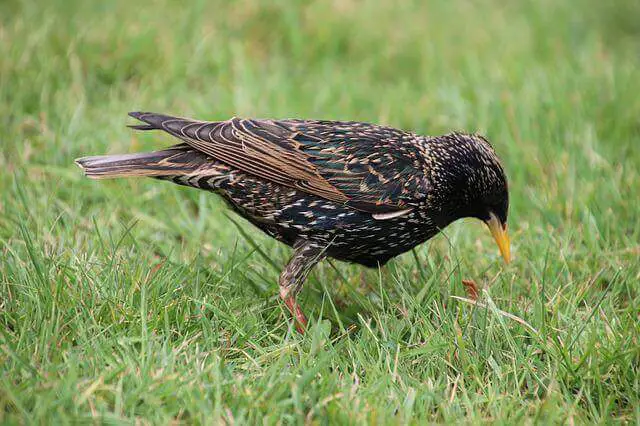
The European Starling is a member of the family Sturnidae, which also includes blackbirds and mynas. The species is native to Europe and Asia, but has been introduced to North America and Australia. The European starling is a small bird, with a length of 20 cm and a wingspan of 30 cm. The plumage is an iridescent black with white spots, and the bill is yellow.
The European starling is a highly adaptable bird, and can be found in a variety of habitats, including forests, grasslands, and urban areas. The bird is omnivorous, and its diet includes insects, berries, and seeds.
- Frequency: 17.22%
- Color: Black with glossy iridescence plumage
- Habitat: Forests, woodlands, backyards, edges, yards, and parks
- Range: North America, Europe, Africa, India, Middle East, China
- Size: 7 – 9″ inches long
- Weight: 60 – 100 grams
- Diet: Insects (ants, beetles, invertebrates), fruits, seeds, berries
- Family: Sturnidae
- Genus: Sturnus
Related: How To Attract European Starlings To Your Yard Fast?
Red-winged Blackbird
The red-winged blackbird is a blackbird species in the family Icteridae. The red-winged blackbird is sexually dimorphic, with the male being all black with a conspicuous red shoulder patch, while the female is mostly dark brown. This bird occurs in wetlands across much of North and Central America.
It is a very aggressive species, especially during the breeding season, when it will defend its nest vigorously against all intruders, including much larger birds such as crows and hawks. The diet of the red-winged blackbird consists mainly of insects, although they will also eat rice, grain, and other seeds.
- Frequency: 17.15%
- Color: All black with red patches on shoulder and a yellow wing bar
- Habitat: Deciduous forests, conifers, roadside, rivers, backyards, parks
- Range: North America, Central America
- Size: 6.7 – 7.1″ inches length
- Weight: 41.5 – 65 grams
- Diet: Seeds and insects (butterflies, dragonflies, moths, frogs, worms, spider, snails, carrion, flies.)
- Family: Icteridae
- Genus: Agelaius
Lesser Goldfinch
The Lesser Goldfinch, Spinus psaltria, is a small passerine bird in the finch family. The adult male has black wings and tail with yellowish-olive upperparts and yellow underparts; the female is similar but has gray-brown upperparts. The breeding habitat is dry open areas with scattered trees across western North America. The nest is constructed high up in a tree or in a bush. This finch typically feeds on seeds, berries and insects.
The Lesser Goldfinch has a large range, estimated globally at 10 million square kilometers. In North America, it breeds from central Alaska and Canada south to northern Mexico. It is a permanent resident throughout most of its range, although some birds may move south in winter. The Lesser Goldfinch typically inhabits open woodlands, scrublands and urban areas.
- Frequency: 16.92%
- Color: Bright yellow underparts, white patches on the tail and wings
- Habitat: Almost any habitat with trees or shrubs, backyards
- Range: Southwestern United States, Washington, Peru, Venezuela
- Size: 3.5 – 4.7″ inches long
- Weight: 8 – 12 grams
- Diet: Tree buds and weed seeds
- Family: Fringillidae
- Genus: Spinus
Eurasian Collared-Dove
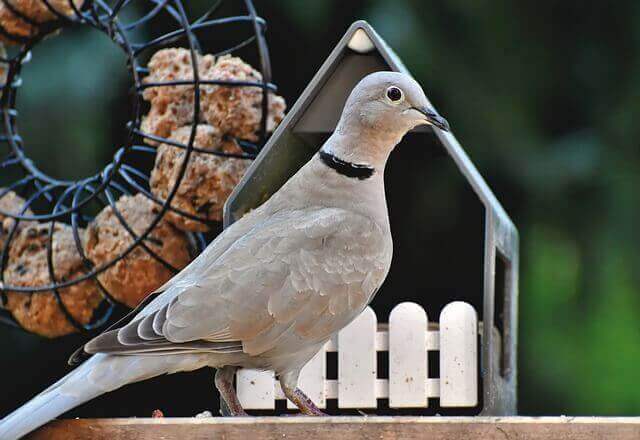
The Eurasian collared dove is a species of dove that is native to Europe, Asia, and North Africa. It is a member of the genus Streptopelia, which includes the collared doves, turtle-doves, and ringed turtle-doves. The Eurasian collared dove is the most widely distributed member of its genus, with a range that extends from Ireland to Japan.
The Eurasian collared dove typically inhabits open woodlands, farmland, and urban areas. It has adapted well to human-altered landscapes and is now one of the most common birds in many parts of its range. The diet of the Eurasian collared dove consists primarily of seeds and fruits.
- Frequency: 15.38%
- Color: Pinkish-gray with ablack half-collar bar with white on its neck
- Habitat: Urban centres, farms, backyards, edges, yards, and parks
- Range: North America, Central America, South America, Europe, Asia
- Size: 13″ inches
- Weight: 150 grams
- Diet: Millet, milo, sunflower, wheat, corn and berries
- Family: Columbidae
- Genus: Streptopelia
Killdeer
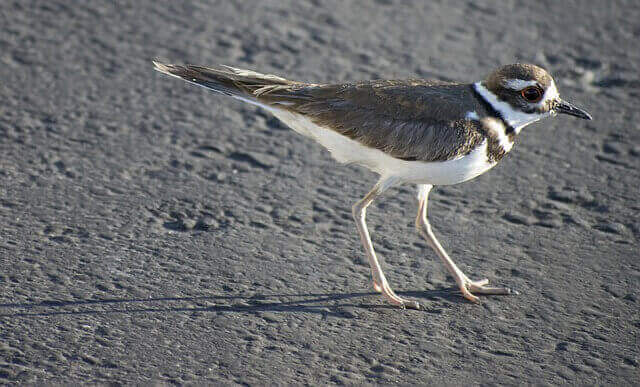
Killdeer are a type of plover. They are found in North America as well as South America. Their diet consists of insects, crustaceans, and worms. Killdeer prefer to nest on the ground in open areas near water. The range of the killdeer is from Alaska and Canada to Central America.
They are found across the United States except Hawaii. The habitat of the killdeer is fields, prairies, and beaches. Their diet consists mostly of insects, crustaceans, and worms. They use their long beak to probe in the sand for food. Killdeer also eat snails, spiders, and millipedes.
- Frequency: 15.09%
- Color: Brown-tan on upper body and white underneath. The white chest has two black bands, brown face with black and white patches.
- Habitat: Beach habitats and coastal wetlands and fields
- Range: USA, Southern Canada, and Mexico
- Size: 7.9 – 11″ inches long
- Weight: 72 – 120 grams
- Diet: Millipedes, worms, snails, spiders, and some seeds
- Family: Charadriidae
- Genus: Charadrius
House Sparrow
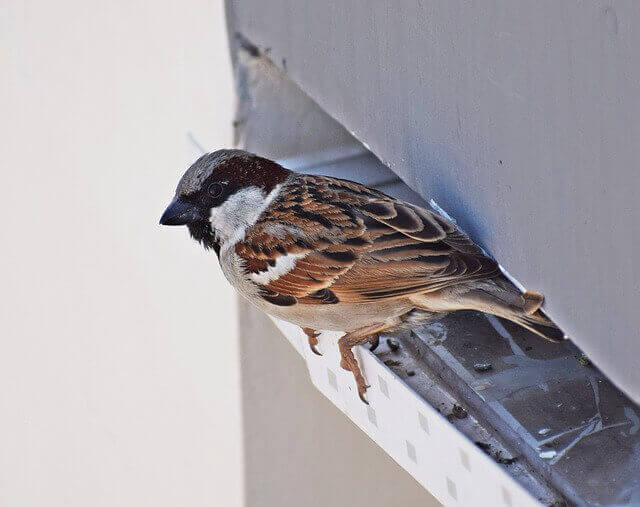
The House Sparrow is a widespread bird that is found in many different habitats. The typical habitat of the House Sparrow is open country with some trees or shrubs. The diet of the House Sparrow consists mainly of seeds and insects. The range of the House Sparrow extends across most of Europe, Asia, and North America. The bird is also found in Africa, Australia, and New Zealand.
In some areas, the House Sparrow is considered an invasive species. The House Sparrow has a wide range of vocalizations. The male bird typically sings a loud “chirp-chirp” to attract mates and defend his territory. The female House Sparrow typically makes a softer “cheep” sound.
- Frequency: 14.81%
- Color: Gray head marking, a reddish-brown back, and gray underparts
- Habitat: Urban centers, suburban areas, backyards, edges, yards, and parks
- Range: North America, Central America, South America, Africa, Australia, New Zealand
- Size: 5.5 – 7.1″ inches in length
- Weight: 25 – 39 grams
- Diet: Insects, beetles, caterpillars, aphids,, grasshoppers, crustaceans, earthworms, vertebrates
- Family: Passeridea
- Genus: Passer
Related: How to Attract Sparrows to your Backyard
Great-tailed Grackle
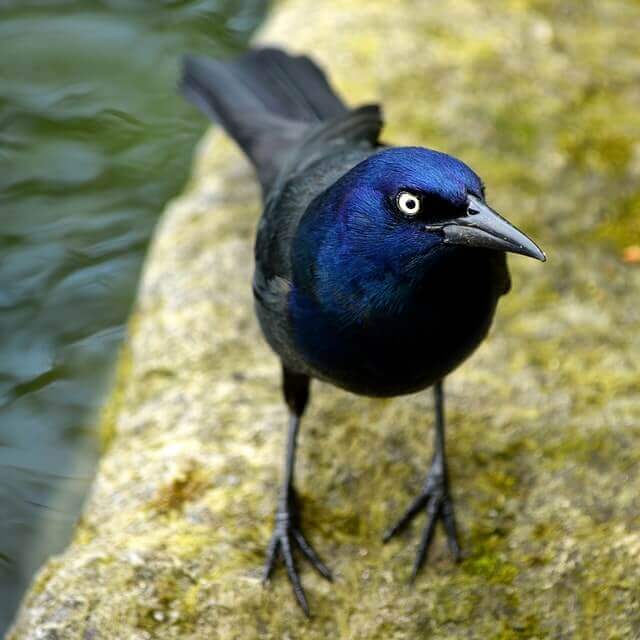
The Great-tailed Grackle is a member of the New World blackbird family and is the largest member of its genus. The Great-tailed Grackle ranges from southern Canada to northern South America and is a permanent resident in most of its range. The Great-tailed Grackle has a black body with a long tail that is often held cocked. The male also has a yellow eye and a glossy purple head and neck.
The female is similar but has a brown head and neck. The Great-tailed Grackle’s diet consists of insects, snails, crayfish, frogs, lizards, small snakes, small mammals, bird eggs, and berries. The Great-tailed Grackle forages in open areas such as fields, lawns, pastures, golf courses, parking lots, and along roadsides.
- Frequency: 14.71%
- Color: Iridescent black with a purple-blue sheen
- Habitat: Pastures, wetlands, mangroves, backyards
- Range: Minnesota, Oregon, Idaho, California, Florida, Southern Canada, Mexico, Venezuela, Ecuador.
- Size: 15 -18″ inches long
- Weight: 200 – 265 grams
- Diet: Seeds, insects, fruits, berries, larvae, eat lizards, nestlings, and eggs
- Family: Icteridae
- Genus: Quiscalus
Song Sparrow
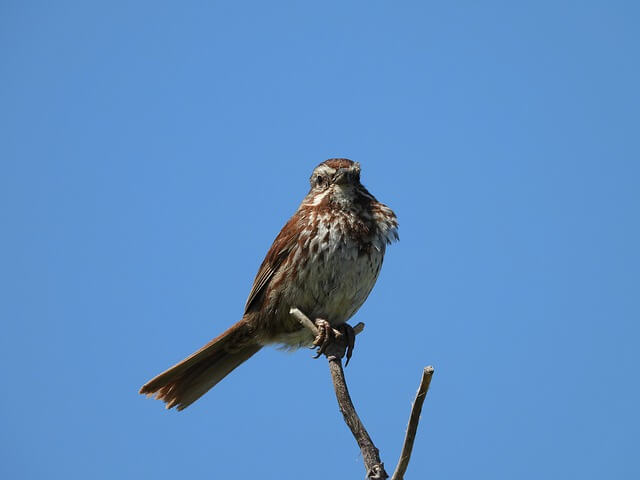
The song sparrow is a New World sparrow. It ranges from southern Canada to northern Mexico, and is the only sparrow found in all 50 states of the United States. The song sparrow is a relatively small bird, with a length of about 5-7 inches and a wingspan of about 8 inches. The plumage of the song sparrow is brown and streaked with white, and the bird has a light brown breast with dark streaks and a white belly.
The song sparrow is found in a variety of habitats, including forests, fields, marshes, and suburban areas. The diet of the song sparrow consists primarily of insects and seeds, although the bird will also eat berries and other fruits.
- Frequency: 14.46%
- Color: Gray head, white cheek, a black bib, rufous neck
- Habitat: Urban centers, farms, backyards, edges, yards, and parks
- Range: Europe, Mediterranean, Asia, Australasia, Africa, and the Americas
- Size: 5.5 – 7.0″ inches
- Weight: 25 – 40 grams
- Diet: Grains, seeds, and insects
- Family: Passeridea
- Genus: Passer
Related Post: How to Attract Sparrows to your Backyard
Verdin
The Verdin is a small songbird that is found in the southwestern United States and Mexico. They are common in desert scrub and chaparral habitats, but can also be found in urban areas. The Verdin’s diet consists mainly of insects, but they will also eat berries and nectar. The Verdin is a small grayish songbird with a yellow head. They have a short bill and long tail. The male and female look alike, although the male is usually slightly larger than the female.
The Verdin has a range of about 2,000 miles, from southern California to northern Mexico. It is a social bird that often forms flocks outside the breeding season. They are monogamous and will mate for life. The female will build the nest, which is usually made of grass, twigs, rootlets, and hair.
- Frequency: 14.08%
- Color: Bright yellow head and reddish-brown shoulder patch
- Habitat: Sonoran Desert, mesquite bosques, urban areas
- Range: Desert Southwest of the United States and Mexico
- Size: 4.5″ inches long
- Weight: 6.8 grams
- Diet: Mainly insects
- Family: Remizinae
- Genus: Auriparus
Dark-eyed Junco
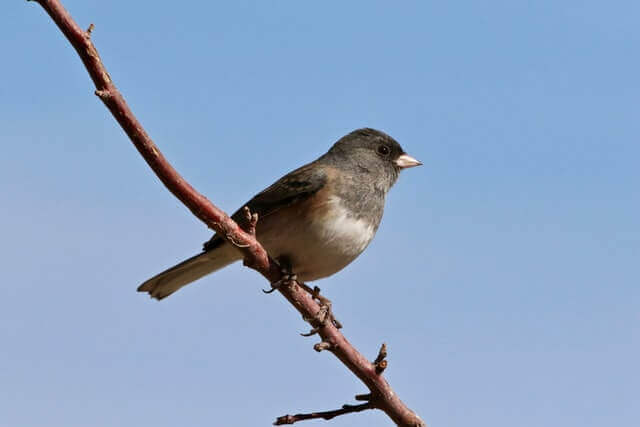
The dark-eyed junco is a beautiful species of junco, a social group of small arboreal New World birds. This small bird is extremely common across much of tropical North America and even into the arctic.These birds have a very varied diet, depending on the season. During winter they will feed on berries and blackberries, mites, wax worms, carrion, and even human foods.
In the spring they become especially apt at making nests in tree bark, in coniferous forests of the western United States and Canada, using coniferous trees as their shelter. For their nesting places, they favor thickets of brush, acacia and oak leaves, hazelnuts, rye, and even garlic. They are particularly drawn to roadsides, fences, and any human structures they can spot.
- Frequency: 13.65%
- Color: Gray head, neck, breast, gray/brown backs and wings, white underside
- Habitat: Wooded areas, forest edges, roadsides, gardens, parks.
- Range: USA and Canada
- Size: 5.1 – 6.9″ inches
- Weight: 18 – 30 grams
- Diet: Seeds, insects, and arthropods
- Family: Passeriformes
- Genus: Junco
Related: Fun Facts About Dark-eyed Juncos
Northern Mockingbird

A member of the Mimidae family, the Northern Mockingbird ranges from southern Canada to northern Mexico. The mockingbird is found in open woodlands, farmland, and urban areas. The Northern Mockingbird is about 8-11 inches in length, with a wingspan of about 13-14 inches. The upperparts are dark brown grayish with white underparts. They have long tails, with a chestnut colored undertail.
The bill is thin and black. The legs are black. Adult males and females look similar. The diet of the Northern Mockingbird consists of insects, fruits, and berries. In the summer, the mockingbird feeds on beetles, ants, grasshoppers, and other insects. In the winter, the diet shifts to include fruits and berries.
- Frequency: 13.38%
- Color: Gray upperparts with white underparts. Black and white wing bars.
- Habitat: Forested areas, parks, and gardens
- Range: Southeastern Canada, USA, Northern Mexico, Cayman Islands, Greater Antilles
- Size: 8.0 – 11″ inches long
- Weight: 40 – 58 grams
- Diet: Berries, fruits, seeds, arthropods, earthworms, and occasionally lizards
- Family: Mimidae
- Genus: Mimus
Related: How to Attract Mockingbirds to your Yard? (Expert Tips)
Say’s Phoebe

Say’s Phoebe ( Sayornis saya) is a small passerine bird. It breeds in western North America, where it is the only member of the genus Sayornis. The bird is named after Thomas Say, an early naturalist in the American West. The breeding habitat of Say’s Phoebe is open country with some trees or shrubs, from coastal California and central Alberta south to Mexico.
Nesting takes place in a cup made of grasses, mosses, bark strips and feathers, lined with hair and down, and built on a ledge, in a tree cavity. Nests are also constructed on man-made structures, such as buildings. The diet of Say’s Phoebe consists mainly of insects. These are caught either in flight or picked up from the ground.
- Frequency: 12.87%
- Color: Pinkish-gray with a black half-collar bar with white on its neck
- Habitat: Farmland, savanna, and open woodlands, close to the water
- Range: Arizona, Colorado, California, Texas, North Dakota, Massachusetts, Alaska, Canada, Mexico
- Size: 7.5″ inches
- Weight: 21 grams
- Diet: Insects, seeds, nectar, and berries
- Family: Tyrannidae
- Genus: Sayornis
Bewick’s Wren
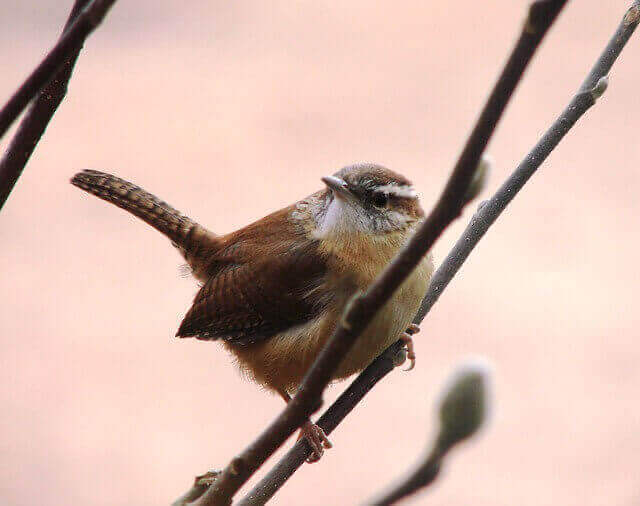
The Bewick’s wren (Thryomanes bewickii) is a small songbird of the wren family, Troglodytidae. It ranges across most of North America, from southern Canada to northern Mexico. The Bewick’s wren is a nonmigratory resident in its range.
The Bewick’s wren occurs in a variety of habitats, including woodlands, brushy areas, and marshes. It prefers open areas with dense understory vegetation. The Bewick’s wren forages for food on the ground or in low vegetation. Its diet is mostly composed of insects and spiders.
- Frequency: 12.71%
- Color: Gray-brown on top, white underneath, with a long white eyebrow.
- Habitat: Open woodlands, thickets, brush piles, hedgerows, near streams.
- Range: British Columbia, southern Ontario, Nebraska, Southwestern Pennsylvania, Maryland, Arkansas, and also in the northern Gulf States.
- Size: 5.5″ inches
- Weight: 9.8 grams
- Diet: Seeds, berries, and insects including beetles, ants, wasps, true bugs, caterpillars, grasshoppers
- Family: Troglodytidae
- Genus: Thryomanes
The backyard birds below have a frequency of less than 12%
- Spotted Towhee 12.15% Frequency
- California Quail 11.97%
- Brewer’s Blackbird 11.85%
- Gambel’s Quail 11.80%
- Ruby-crowned Kinglet 11.58%
- Black-billed Magpie 11.56%
- Western Meadowlark 10.55%
- Mountain Chickadee 10.42%
- Anna’s Hummingbird 10.35%
- Black Phoebe 9.82%
- California Scrub-Jay 9.23%
- Yellow Warbler 8.70%
- Western Kingbird 8.61%
- Brown-headed Cowbird 8.53%
- Barn Swallow 8.46%
- Steller’s Jay 8.16%
- Marsh Wren 8.10%
- Horned Lark 7.39%
- Northern Rough-winged Swallow 7.19%
- Phainopepla 7.09%
- Western Wood-Pewee 7.09%
- Yellow-headed Blackbird 6.94%
- Black-tailed Gnatcatcher 6.93%
- Black-throated Sparrow 6.78%
- Brewer’s Sparrow 6.63%
- Orange-crowned Warbler 6.50%
- House Wren 6.43%
- Bullock’s Oriole 6.26%
- Loggerhead Shrike 6.21%
- Western Tanager 6.06%
- American Crow 6.05%
- Cassin’s Finch 5.88%
- Cliff Swallow 5.53%
- Savannah Sparrow 5.38%
- Rock Wren 5.37%
- Abert’s Towhee 5.35%
- Chipping Sparrow 5.23%
- Northern Pintail 5.22%
- Black-chinned Hummingbird 5.18%
- Warbling Vireo 5.09%
- Greater Roadrunner 5.08%
- Blue-gray Gnatcatcher 5.01%
Frequently Asked Questions
What are the black birds in Nevada called?
The black birds in Nevada are called Red-winged Blackbird, Brewer’s Blackbird, Yellow-headed Blackbird, Tricolored Blackbird, Rusty Blackbird and the Great-tailed Grackle. All of these birds are found in the western US and Canada.
Are there finches in Las Vegas, Nevada?
There are eight species of finches in Las Vegas, Nevada, the House Finch, Lesser Goldfinch, Cassin’s Finch, American Goldfinch, Black Rosy-Finch, Purple Finch, Lawrence’s Goldfinch and the Gray-crowned Rosy-Finch. All of these species are found in the Mojave Desert. The House Finch is the most common species in Las Vegas.
What are Nevada bluebirds?
There are two types of bluebirds in Nevada, the Western Bluebird and the Mountain Bluebird. The Western Bluebird is a small thrush with blue feathers and a red breast. The Mountain Bluebird is slightly smaller than the Western Bluebird and has blue feathers with white belly. Both species of bluebirds eat insects, berries, and fruits.
What kind of birds are at Lake Mead?
Lake Mead is home to a variety of different birds. Some of the most common birds that can be found at Lake Mead are peregrine falcons, bald eagles, burrowing owls, ruddy ducks, ring-necked ducks, and great blue herons. There are also a number of different types of songbirds that can be found in the area. The bird population at Lake Mead is constantly changing as different species migrate in and out of the area.
Are there ravens or crows in Las Vegas?
There are indeed ravens and crows in Las Vegas. While the city is most famous for its casinos and resorts, it is also home to a variety of wildlife. Ravens and crows are both common birds in the area, and can often be seen flying around or perching on buildings.
Are Ravens in Nevada?
Ravens are one of the most common birds in Nevada, with a frequency of occurrence of 26.60%. They are found in all parts of the state, from the mountains to the deserts. Ravens are intelligent birds, and their presence in Nevada is evidence of their adaptability to different environments.
Are there blue jays in Nevada?
Blue Jays are not a common sight in Nevada, with an occurrence rate of only 0.0065% according to eBird. However, there have been sightings of the blue bird in the state, mostly in the southern region. It is speculated that the bird may be migrating from California or Arizona due to the lack of food and water in those areas.
Are there egrets in Nevada?
Yes, there are egrets in Nevada! There are four species of egrets that can be found in the state, the Great Egret, Snowy Egret, Cattle Egret, and Reddish Egret. The most commonly seen in Nevada is the Great Egret. These beautiful birds can typically be found near bodies of water, such as lakes, rivers, and wetlands. However, they will also sometimes venture into more arid habitats in search of food.
Are there loons in Nevada?
There are four species of loons that can be found in Nevada are the common loon, the Pacific loon, the red-throated loon, and the yellow-billed loon. Common loons are the largest and most common of the four species and can be found in both freshwater and saltwater habitats.
Are there catbirds in Nevada?
According to eBird, there are catbirds in Nevada, but they are very rare with a frequency of only 0.1658%. Catbirds are typically found in the eastern United States, but they have been known to travel westward. In Nevada, catbirds are most likely to be found near bodies of water such as lakes and streams.
Are there parrots in Nevada?
There are no parrots in Nevada. This is because the state does not have the climate that parrots need to survive. Parrots are tropical birds, and they need a warm, humid environment to thrive. Nevada is a desert state with a very dry climate. The average temperature in Nevada is only about 54 degrees Fahrenheit. That is too cold for parrots. Parrots also need a lot of vegetation to eat and live in. Nevada is mostly desert with very little vegetation.
Are there peacocks in Nevada?
Although there are no peacocks in Nevada, but there are peafowls. Peacocks are a type of peafowl, but not all peafowls are peacocks. Male peacocks are called peacocks, while female peacocks are called peahens. Male peafowls have large tails with colorful feathers that they spread out when they’re trying to impress a female. Female peafowls don’t have tails that are as large or as colorful as the males’.
Are there starlings in Nevada?
Yes, there are starlings in Nevada. In fact, they are quite common. The only type of starling that is found in Nevada is the European Starling. These birds are not native to North America, but were introduced in the 1800s. They are now found all over the continent.
Are there roadrunners in Nevada?
The Greater Roadrunner is the only species of roadrunner found in Nevada. These birds are interesting to watch as they run down their prey, which can include lizards, snakes, rodents, and insects. The roadrunners in Nevada are found in the southern and eastern parts of the state.



